Semiannual newsletter on company projects, news, and events.
Building A Better Watershed Together: RCWD and HEI
Located in the northern Twin Cities Metro area, the Rice Creek Watershed District (RCWD) has been working hard to manage water quality and quantity and improve the resiliency of their water resources. Houston Engineering, Inc. (HEI) is proud to collaborate with them as their District Engineer and be involved in many of these amazing projects.
continued

INSIDE THIS ISSUE
Project Feature: Eastern Polk County Stream Restoration
Featured Service Area: Travel Demand Modeling
Comprehensive Watershed Solutions
Project Snapshots
Employee Spotlights
News and Events
Remembering Hank Trangsrud
New Locations: Alexandria and Bemidji
Conference Season
On the cover: The RCWD engages in countless projects and programs that preserve and enhance the District's water resources, including this restored portion of Rice Creek.

Building a Better Watershed, Together
RCWD and HEI
About the RCWD
Since its establishment in 1972, the RCWD’s mission has been to manage, protect, and improve the water resources of the District through flood control and water quality projects and programs. RCWD’s mission complements HEI’s commitment to making positive impacts to communities through collaborative partnerships and innovation, making us strong and aligned.
Our History of Collaboration
Where is the District?
The District extends from White Bear Lake to the Lino Lakes Chain of Lakes and down to the Mississippi River. The RCWD encompasses 186 square miles, including 28 municipalities and four metro counties. It is uniquely located in a transition zone between long established urban communities, recent development expansion, and agricultural areas poised for a change in land use. This geography, combined with changing climactic trends, has accelerated the burden and expectations placed on stormwater management infrastructure. The RCWD’s surface topography and geology, created by glaciers many thousands of years ago, left a wealth of surface water resources (including numerous lakes, streams, and wetlands) that are enjoyed by countless residents and visitors to the area. As such, preserving and improving the water quality of these resources is one of the RCWD’s highest priorities.
The water resources world runs in tight circles, especially when specialized services are required to best serve a community. Former HEI employee Mark Deutschman leveraged his relationships with state water resource leaders to introduce HEI to the RCWD, which eventually led to the RCWD’s selection of HEI as its District Engineer. The RCWD and HEI quickly built a strong working relationship, and for more than 17 years HEI has committed ourselves to the goal of being a seamless extension of the RCWD’s staff. In his role as District Engineer for nearly a decade and Assistant District Engineer before that, Chris Otterness has provided continuity that further strengthens the relationship. He has helped the RCWD through several milestone projects that set the District up for future success, including major grant initiatives and its 2020 Watershed Management Plan Update.
District Programs
In order to invest in and prioritize initiatives that can help achieve its goals, a watershed district must have a well-developed plan that is committed to by the board, staff, and other stakeholders. During the RCWD’s Watershed Management Plan Update in 2020, the District Board of Managers identified and prioritized issues within the watershed to guide implementation and funding efforts for the next 10 years. The RCWD set up programs that outlined the next steps for mitigating these issues. These issues and programs serve as the backbone for the RCWD’s organization, budgeting, and implementation of its vision.
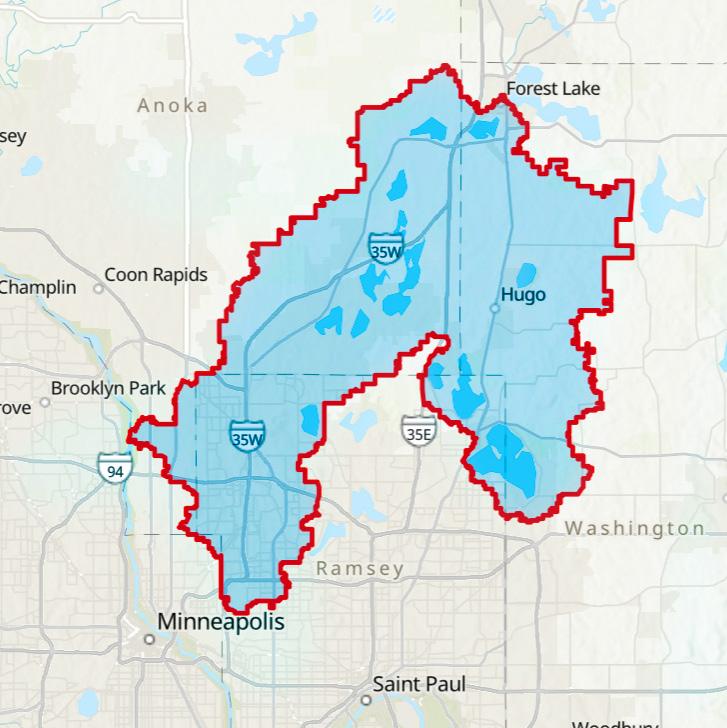
Learn more about RCWD projects and programs in the next few pages.
District Programs
Communications and Outreach
• Coordination and communication with cities, counties, and the public are central to RCWD project planning and implementation. HEI regularly supports RCWD with communication and outreach efforts.
• Every public interaction is treated with respect and priority, regardless of size. This respectful approach guides all stakeholder engagement.
• During the 2020 Watershed Management Plan Update:
○ RCWD and HEI collaborated with local and state agencies, which ensured regulatory compliance while addressing community needs.
○ Outreach efforts helped secure local support, and this local buy-in contributed to smooth project implementation.
Capital Projects
• A crucial step in the Watershed Management Plan Update was to identify the capital improvement projects that would best address the RCWD’s prioritized issues and meet their goals.
• During the last grant cycle, HEI helped the RCWD prepare grant applications, and the RCWD was awarded with approximately $1.5 million in grant funding.
○ A notable project that is funded by these grants is the Jones Lake Outlet Modification and Dredging project, which received a $1.17-million Stormwater Implementation Grant from the Minnesota Pollution Control Agency.
Public Drainage
Drainage authorities serve as caretakers for public drainage systems that are collectively owned by landowners whose properties derive benefit from the system.
The RCWD inspects, maintains, and repairs 116 miles of public drainage systems made up of 22 individual systems traversing through three counties and 16 cities. These systems—which consist of open ditch, drain tile, and urban storm sewer—are the “arteries” of the RCWD and provide the linkage between rural and urban communities, lakes, and Rice Creek.
Due to rapid urbanization, the burden placed on these systems and the desired level of service is greater than ever. The RCWD addresses this dichotomy by prioritizing restoration and seeking partnerships to increase storage along and upstream of these systems. Its regulatory program also provides rules that prevent activities that can obstruct the drainage systems and their management. This approach balances the needs of upstream landowners with the protection of downstream landowners.
Lakes and Streams
• The RCWD places a high priority on protecting and improving water quality in streams, rivers, and lakes.
• HEI has supported RCWD with several recent projects that improve water quality and resiliency within the District's lakes and streams, including the ongoing Jones Lake Outlet Modification and Dredging project.
• HEI also identified the source of phosphorus loading that drives algal blooms in Centerville Lake and evaluated project funding options.
Information Management
In 2008, the RCWD began a 3-year investment in developing a Districtwide Modeling Program that would serve as a primary decision-making tool for many of their other programs. The novel solution developed by HEI originally consisted of 14 individual hydrologic and hydraulic models and a riverine model that were integrated to reflect the influence that various drainage systems and Rice Creek have on each other. The value provided by this suite of tools has been incalculable and has included uses varying from project design, to regulatory flood elevations, to cost-share prioritization. These models have not only provided a sound basis for RCWD’s technical decision making, they also have been shared with many other stakeholders to provide more accurate and justifiable decisions.
The investment did not end with the completion of the model in 2011. The model has been augmented to simulate future land use and climatic conditions, modified to support the Federal Emergency Management Agency remapping, and annually updated to include more precise data and reflect changing infrastructure. The RCWD has also made many other investments in its information management as well, including the purchase and implementation of HEI’s Drainage DB and MS4Front data management solutions, which take information traditionally residing in paper documents and place it in specialized databases that are customized to the RCWD’s workflows and needs.
Regulatory
The RCWD has adopted a set of rules to guide decision-making regarding stormwater management, soil erosion and sediment control, floodplain alterations, wetland alterations, public drainage system management, and other activities within its boundaries. These rules are implemented through a regulatory program that verifies that the design and implementation of construction activities avoid harm to infrastructure and resources within the RCWD. In doing so, the regulatory program complements the activities completed through the RCWD’s other programs.
An efficient rule set must adapt to an improved understanding of the environment. To this end, HEI supports rule updates in a manner that promotes more efficient implementation of rules and policies. This approach helps safeguard the RCWD’s resources while streamlining the permitting process for applicants.
District Facilities
• The RCWD has made significant investments over the years to improve water quantity and quality through various infrastructure projects. Like all infrastructure, these projects require ongoing maintenance to remain effective. RCWD prioritizes the upkeep of its facilities, sometimes replacing large portions of the facility to ensure long-term performance.
• For the Priebe Lake Outlet Modification, HEI assessed the original structure and recommended a redesign that resulted in a more reliable outlet that is less prone to ice buildup and clogging.
Ramsey County Ditches 2, 3, and 5
The RCWD manages Ramsey County Ditches (RCD) 2, 3, and 5 as the drainage authority. After an extreme rainfall event in July 2011 that caused flooding in many areas of the district, the cities of New Brighton, St. Anthony Village, and Roseville petitioned the RCWD to develop and implement the RCD 2,3, and 5 Basic Water Management Project to address flood risks in the watershed. Phase I focused on the current conditions, challenges, and opportunities regarding stormwater management and flood damage in the cities. Phase II developed a comprehensive stormwater management plan for the RCWD.
HEI assisted with the development of both phases and the implementation of many of the individual projects aimed at improving flood resiliency in the watershed. In the end, HEI recommended 10 projects that will reduce flood damage, improve water quality, and meet the petitioners’ objectives.
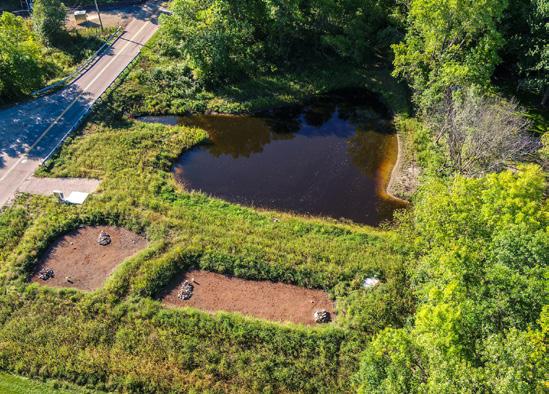

Leading the Project Chris Otterness cotterness@houstoneng.com

Hansen Park Project

Extreme rainfall in 2011 caused flooding in many areas of the district, leading to the need for the RCWD’s programs and more extensive flood protection measures.
Bald Eagle Lake Iron-Enhanced Sand Filter
To improve water quality in Bald Eagle Lake, the RCWD proposed constructing a wet pond and Iron-Enhanced Sand Filter (IESF) along RCD 11. The project site is located between Bald Eagle Lake and White Bear Lake on two undeveloped lots. This area provides minimal treatment for stormwater runoff that enters RCD 11, which eventually discharges into Bald Eagle Lake. The RCWD retained HEI to complete the feasibility study for the proposed wet pond and IESF.
After being awarded a Clean Water Fund grant through the Minnesota Board of Water and Soil Resources to construct the project, the District contracted HEI to proceed with plan development and construction administration. The design reduces the concentration of phosphorus by settling larger particulates in the wet pond, and filters out fine sediment and dissolved phosphorus by pumping the ponded water through an IESF system.
The design needed to accommodate high-discharge, short-duration flows from the local neighborhood as well as moderate-discharge, long-duration flows from White Bear Lake. It also needed to consider long-term maintenance for both the pumping system and pond dredging. Tight site constraints required well-planned layout and grading of access routes for this maintenance.
Due to watershed urbanization that largely preceded the implementation of modern stormwater management rules, Hansen Park and the neighborhoods north to Pike Lake were susceptible to flooding, and the park's pond had poor water quality. Hansen Park presented an opportunity to improve both water quality and stormwater flow management through modifications to its pond and dam as part of a comprehensive project. This design married together several innovative best management practices, including a three-stage dam and outlet design, targeted removal of sediments causing internal phosphorus loading, and a first-of-its-kind, iron-enhanced sand filter practice that treats discharged water on a nearly 24/7 basis.
HEI also completed multiple surveys to guide the project from start to finish, and oversaw the dredging of 60,000 cubic yards of material from the site. Using mechanical dredging, which requires heavy machinery to excavate and remove materials, HEI helped manage difficult dredging and material challenges.
This project is making a real difference for our lakes, wildlife, and park visitors. By keeping 150–200 pounds of phosphorus out of

Pike Lake and Long Lake each year, we’re helping the water stay cleaner and healthier for everyone to enjoy. Plus, we added space to hold nearly 9 million gallons of stormwater, so the park is better protected from flooding during heavy rains, native plants were also added throughout the site to bring back natural beauty and create habitat for wildlife. Park trails were improved so they’re more resilient and easier to use, even after big storms. It’s all about making the park a safer, more vibrant place.


Leading the Project
Dennis McAlpine dmcalpine@houstoneng.com
Jones Lake Outlet
Modification and Dredging Project on Ramsey County Ditch 2
RCD 2 serves as a vital regional stormwater conveyance system supporting the cities of Roseville, St. Anthony, and New Brighton. This project will address the urgent need to mitigate widespread and recurring flooding throughout the watershed, which has been exacerbated by increasingly intense rainfall events and limited local mitigation options.
This project will consist of: open water dredging of Jones Lake; excavation of its fringe sediments; establishing a sediment forebay; associated material handling (dewatering, hauling); and replacement of the failing existing outlet structure. Our team performed field surveys to create detailed topographical documents that outline the outlet and embankment, dewatering site, and flood mitigation sites.
HEI will be preparing a wetland delineation report, environmental assessment documents, permitting applications, and design and construction documents for the Jones Lake Outlet Modification and Dredging project. After review by the City of New Brighton and RCWD staff, final designs will be used in bidding and construction management for Phase 1 of the project.



"Floodplain mitigation works best when driven by solid modeling, stakeholder engagement, and resource-focused outcomes."
– Nick Tomczik RCWD District Administrator
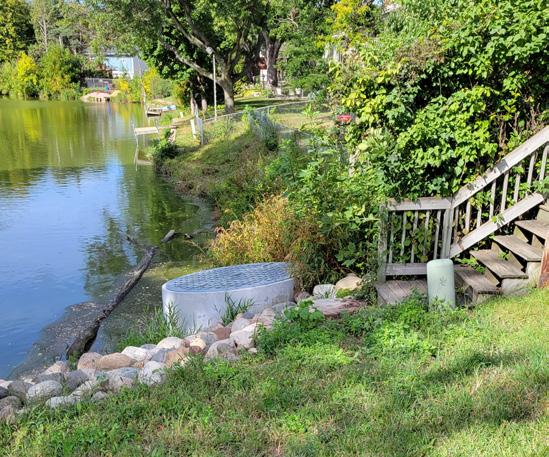
Priebe Lake Outlet Modification
In support of the RCWD’s long-standing water level management efforts—initiated in 1979 following petitions from the cities of White Bear Lake and Birchwood Village—HEI completed a comprehensive review of the Priebe Lake outlet system. The outlet was originally constructed to regulate water levels and provide a predictable discharge from Priebe Lake.
The work performed by HEI included a thorough evaluation of the outlet’s current condition and the development of repair alternatives to ensure continued functionality. The team began by reviewing original design documents to verify system components and identify any deviations from the initial plans.
A detailed field survey was conducted to assess the condition of the inlet and outlet structures.
To evaluate the internal condition of the storm sewer system, HEI coordinated with a subcontractor to perform televising of the outlet pipe. The team also located storm sewer connections entering the outlet pipe downstream of the lake. Based on the findings, HEI identified necessary repairs and developed alternative solutions, including preliminary cost estimates. These concepts were reviewed in collaboration with RCWD staff and ultimately led to the replacement of the outlet structure on Priebe Lake with HEI providing design, permitting, and construction management services.
This project’s focus is to protect homes and preserve nature. Since 2022, it has helped keep Priebe Lake neighborhoods safe from flooding and ensures stormwater flows smoothly where it should. These improvements safeguard the health of more than 200 acres of watershed that eventually feeds into White Bear Lake—keeping this treasured resource balanced and thriving for generations to come.


jlewis@houstoneng.com
Featured Project: Eastern Polk County Stream Restoration
The Project HEI supported Polk County Public Works and several local partners, including the Polk County Conservation Board and the cities of Ankeny, Altoona, Pleasant Hill, and Des Moines, IA, in the development of a watershed-scale stream restoration and stabilization plan and project in Fourmile and Camp creeks.
The first phase of the planning effort included public engagement and coordination with local agencies and cooperating technical partners to solicit stakeholder input, establish goals, and identify restoration priorities. The original plan included more than 140,000 acres and more than 14 miles of streams, with the highest priority sites moving into the detailed assessment and design phase in early 2024. Eleven Affected Resource Areas (ARAs) were selected as priority sites for implementation of stream restoration/stabilization. Implementation required stream assessment, Section 404 permit coordination with the US Army Corps of Engineers, floodplain permitting, and designs that utilize a wide array of restoration and stabilization strategies to protect and improve more than 10 miles of streams. HEI led design on 7 of the 11 stream sites and provided hydraulic modeling and permitting of 4 sites designed by our subconsultant, RDG Planning & Design.
When completed, this project will be the largest, most comprehensive, watershed-based stream restoration project to date in the State of Iowa. As of October 2025, 6 of the 11 stream segments have been completed or are under construction, with the remaining 5 scheduled for construction in 2026.
Project ARAs: Pre-Construction
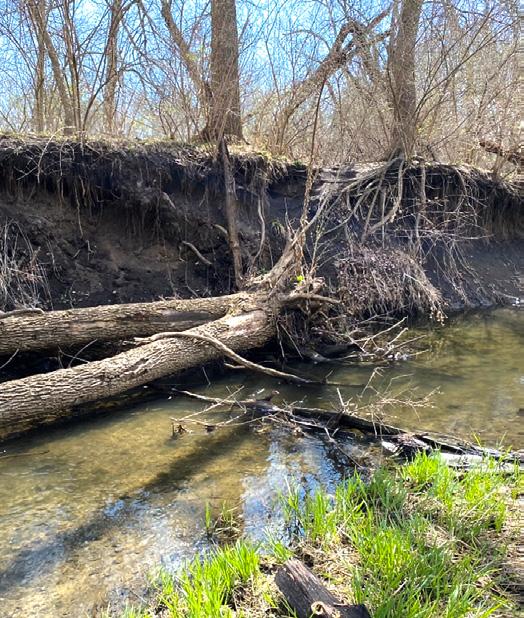
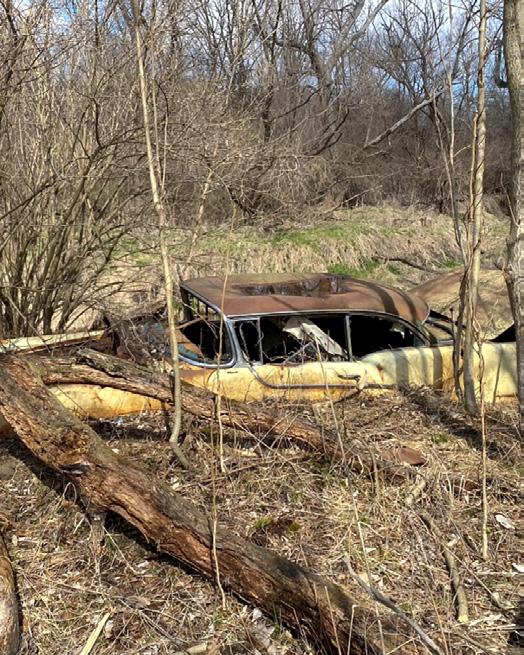


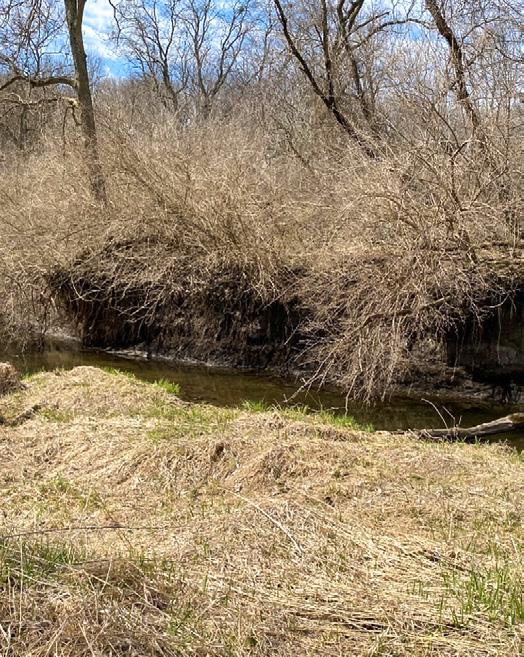

Construction

Contractor placing toe rock to protect the streambank.
Toe Rock with Bank Shaping or Floodplain Benching
Toe rock, bank shaping, and floodplain benches are integrated techniques for streambank stabilization and erosion control. Toe rock reinforces the base of eroding slopes, preventing undercutting by fast-moving water. It’s especially useful in areas with lateral channel movement or downcutting and is often paired with bank shaping and vegetation to enhance stability. Bank shaping involves grading streambanks to angles that support plant growth and resist erosion. It’s commonly combined with toe protection, multi-stage channels, and in-stream structures to improve bank resilience, reduce flood risk, and support recreational access. Vegetation is key to maintaining stability after shaping.
Floodplain benches allow floodwaters to spread out, reducing shear stress on streambanks. This helps minimize erosion and creates conditions for vegetation to establish and further stabilize the area. Together, these methods create durable, ecologicallysound stream environments that balance structural integrity with natural restoration.
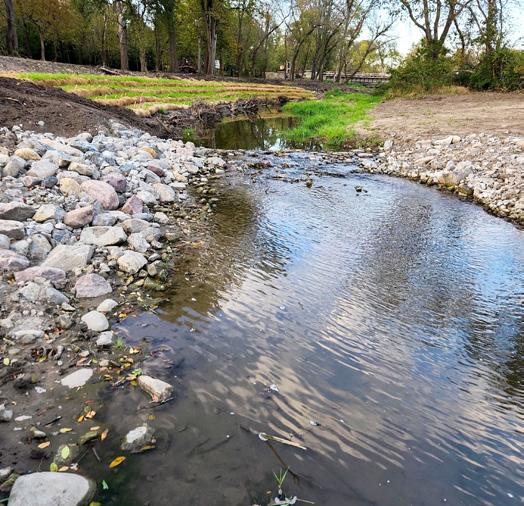
A rock riffle to control the stream grade and prevent further downcutting.
Rock Riffles
Rock constructed riffles are intended to provide grade control, regulate sediment transport, and diversify flow regimes in the channel. This project will utilize both rounded field stone and Class E riprap to construct the riffle and, where possible, native materials will be used as chinking rock. These structures are strategically placed along the profile to restore the channel grade and prevent future downcutting from occurring. The rock riffles are designed to concentrate low flows to the center of the riffle while maintaining capacity for the bankfull flows. This riffle on Camp Creek provides control of channel erosion and fish passage, two important environmental benefits of the project. Just upstream of the riffle is a section of toe wood fiber encapsulated soil lifts. These bioengineering techniques stabilize reaches with minor to moderate erosion using more natural materials that support desirable vegetation and habitat than hard armoring with rock or stone.






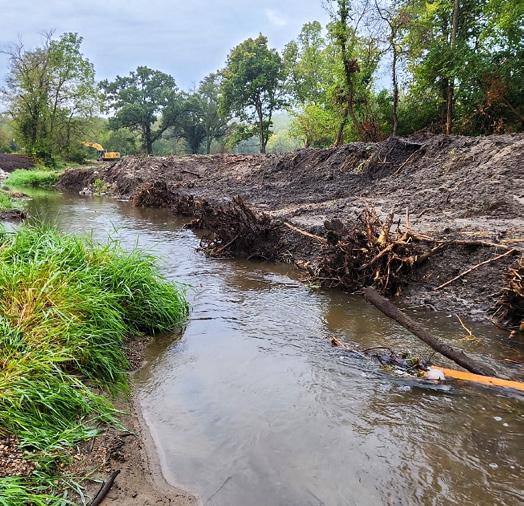
Toe wood (construction in progress) along the streambank.
Toe Wood
Toe wood is a natural method used to protect the toe of streambanks from erosion. It involves placing logs and rootwads along the base of the bank to slow down fast-moving water and stop it from eroding away the soil. This technique works well in areas where the stream is shifting sideways or has cut down into the streambed. Toe wood is often combined with reshaping the bank and planting native grasses and plants above it. These plants help hold the soil in place and create healthy, stable streambanks for the long term.
Project Highlights
• HEI surveyed 10 miles of stream in less than a month using drone-based LiDAR and manual methods, beating seasonal constraints and keeping the project on track.
• Fast-tracked design and permitting ensured alignment with a tight December 2026 deadline.
• Powered by cross-office collaboration, the project highlights HEI’s ability to deliver complex work quickly and efficiently.

Featured Service Area: Travel Demand Modeling
Driven to Create Sustainable Models Where Data Meets the Road
Meet Brett Gunderson
Brett brings nearly a decade of experience in travel demand modeling and transportation planning to HEI. He has worked with metropolitan planning organizations, state departments of transportation, and local governments to forecast travel patterns, assess development impacts, and support corridor studies and long-range planning. His modeling expertise has strengthened grant applications by giving agencies the technical foundation to secure funding.

These models help answer questions such as:
• What will traffic look like in 20 years?
• How will new developments or highway connections shift travel patterns?
• Will proposed projects or policies reduce congestion, greenhouse gas emissions, improve safety, etc.?
• What is the potential demand for new or expanded transit services?
• How could changes in travel behavior, such as remote work or electric vehicle adoption, affect long-term performance?
Benefits to Clients and Communities
Expanding HEI’s Transportation Capabilities
As communities continue to evolve, HEI is pleased to offer a new solution that supports thoughtful, forward-looking transportation planning. Travel demand modeling uses advanced modeling techniques to forecast how people and goods will move in the future, helping communities and agencies make confident, informed decisions. By combining demographic trends, land use patterns, and economic growth forecasts, travel demand modeling provides a structured way to evaluate how transportation networks will perform under a variety of future conditions.
Why Travel Demand Modeling?
Transportation challenges become more complex as communities grow and change. Travel demand modeling is a powerful tool that helps decision-makers anticipate future conditions and test potential strategies before making investments.
Travel demand modeling provides a foundation for making complex transportation decisions. By using data-driven forecasts and scenario testing, communities can explore multiple futures with greater confidence. Key benefits include:
• Smarter Planning: Supports long-range transportation plans and growth strategies.
• Prioritization: Identifies where improvements will have the greatest impact.
• Scenario Testing: Evaluates potential outcomes of projects, developments, or policy changes.
• Multimodal Insight: Considers roadway, transit, and bicycle travel.
• Funding Support: Strengthens grant and funding applications with technical backing.
Travel demand modeling complements HEI’s transportation planning and engineering services by enhancing corridor studies, intersection analyses, long-range plans, and grant writing— ensuring clients receive a complete picture to guide both near-term projects and future investments.
Learn More About Transportation Planning
Check out our Transportation Planning Page: houstoneng.com/trplan/ and the project example below.
Lincoln County Safe Streets and Roads for All Comprehensive Safety Action Plan
Lincoln County, SD, received funding through the Safe Streets and Roads for All (SS4A) program to develop a countywide safety action plan, partnering with HEI. The initiative aims to improve transportation safety, reduce injuries, and save lives by identifying risks and setting clear safety objectives. Public engagement is central to the process, with activities conducted early and throughout the project to gather diverse input and validate proposed solutions. HEI used Social Pinpoint, an online tool, to broaden community participation.
The plan is informed by 2020-2024 crash data, roadway, and land use information to uncover patterns and guide safety improvements. It recommends strategies such as infrastructure upgrades, policy changes, and performance metrics.
Aligned with the US Department of Transportation Safe System Approach, the plan emphasizes shared responsibility and proactive measures to create layered protections across Lincoln County’s roadways.
Scan to View the Social Pinpoint Site

From Planning to Progress A Holistic Approach to Comprehensive Watershed Solutions
At HEI, watershed planning isn’t just a phase, it’s a full-spectrum commitment that spans from vision to reality. HEI has become a trusted partner in guiding watershed projects through planning, design, and construction—delivering resilient infrastructure and cleaner water for communities.
HEI’s expertise covers a wide array of watershed planning programs, including Clean Water Act Section 319 water quality initiatives, FEMA flood hazard mitigation, as well as:
Natural Resources Conservation Service: Watershed Solutions
HEI has been involved in various Natural Resources Conservation Service (NRCS), Watershed and Flood Prevention Operation, and Regional Conservation Partnership Program projects across Region 7 states. The NRCS programs provide financial assistance to project sponsors to plan, design, and implement watershed solutions for flood risk reduction, watershed protection, dam assessment and rehabilitation, agricultural water management, and other projects. Our staff work hand-in-hand with project sponsors, agency stakeholders, and the public to understand concerns and develop solutions that fit within the program framework. The plans follow the NRCS process to comply with National Environmental Policy Act (NEPA) and other requirements. NRCS provides funding assistance for engineering and construction once the plans are approved.
Stormwater and Water Quality: Urban Innovation
HEI is a regional leader in stormwater and water quality planning, offering innovative solutions that integrate hydrologic modeling, GIS targeting, and green infrastructure to address urban flooding and pollution challenges. Our proprietary tools like MS4Front and targeted digital campaigns further support clients in meeting MS4 reporting and longterm water management goals.
Lake Restoration and Cultural Stewardship
HEI has extensive experience in lake restorations, working with both public agencies and private stakeholders across the Midwest. Our clients' projects include comprehensive planning, dredging, shoreline improvements, and water quality enhancements, as seen in efforts like the McKinley Lake Restoration and Otter Creek Lake Restoration in Iowa.
HEI’s team has collaborated with entities such as the Nebraska Game and Parks Commission and the Iowa Department of Natural Resources, often under Public Private Partnership arrangements. Our team’s approach integrates environmental feasibility, permitting, and community engagement to deliver sustainable and beneficial lake environments.
Southern Sarpy Watershed Management Plan
Client: Papio-Missouri River Natural Resources District
The goal for the Southern Sarpy Watershed Management Plan (SSWMP) is to protect natural resources and local infrastructure from the changes in stormwater dynamics due to development within the watershed. HEI addressed four technical factors related to development and its effect on stormwater: water quantity, hydraulics, water quality, and stream stability.
HEI analyzed baseline and potential post-development conditions to develop stormwater controls that will help guide the anticipated rapid development in the watershed. An alternatives analysis was performed to assess peak flow management and stream stability
Funding
Oftentimes, watershed planning and implementation efforts can be supported through grants. HEI has a long history assisting local partners secure and manage watershed planning funding through a diverse range of programs. This history includes strategic planning efforts to align goals to federal or state programs, grant writing, and cost-benefit analyses. Whether watershed planning goals pertain to flood reduction and mitigation, water quality, ecosystem restoration, or infrastructure rehabilitation, the HEI team is committed to assisting clients secure a practical and reliable funding pathway to make their project a reality.
Looking Ahead
With ongoing planning efforts in watersheds across Nebraska, Iowa, Minnesota, and North Dakota, HEI continues to shape the future of watershed management. Whether it’s a feasibility study, stakeholder facilitation, or final design, HEI brings clarity, coordination, and commitment to every drop of water it protects.
Learn More
Watersheds: houstoneng.com/Watersheds Geospatial: houstoneng.com/Geospatial MS4Front: houstoneng.com/MS4Front
alternatives. We also provided stream assessments to determine existing habitat, wetlands, potential restoration, profile information, sediment transport, bank erosion, ordinary high-water marks, and existing vegetation. This information was used to identify future projects and associated costs as well as finalize policies and ordinances to be used within the watershed. The project included coordination with local agencies and stakeholders as well as outreach efforts to gather input from the public and inform them of existing problems and proposed planning solutions. The SSWMP was completed in 2024. Learn more about this project: houstoneng.com/sarpy
PROJECT SNAPSHOTS
We’d love to showcase all that we do at HEI, but we’d run out of pages! Here’s a quick overview of some projects we’ve been working on or recently completed.
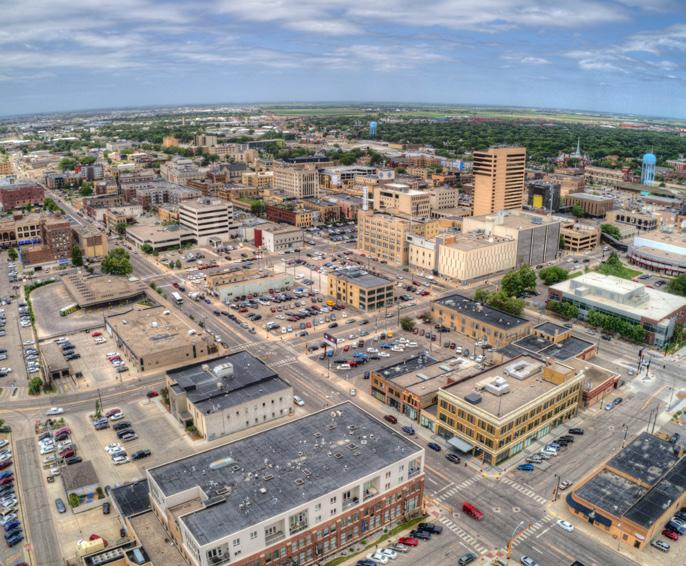
Once complete, this project will help replace more than 2,000 aging lead service lines that connect Fargo homes to the municipal water system.
City of Fargo Lead Water Service Line Replacement Program
Fargo, ND
In 2025, the City of Fargo initiated the Lead Water Service Replacement Program to replace aging service lines and minimize the public’s exposure to lead in drinking water. With support from state grant funding, the City has partnered with our team to develop a plan to replace lead service lines across Fargo’s residential neighborhoods. These lines, many of which are located in long-standing neighborhoods, pose risks not only due to the health effects of lead exposure, but also because of their deteriorating condition.
Today, the team has developed plans for a system that can be replicated across each home. With the completion of the first design phase, which includes more than 100 properties, the City will be one step closer to eliminating lead risks from its water system and investing in a safer future for Fargo residents.
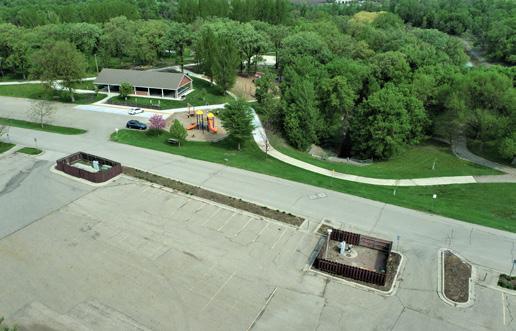
Completed Designs
Existing Structures

Reconstruction of Storm Sewer Lift Stations #11 and #57
Fargo, ND
In partnership with the City of Fargo, HEI began work on the reconstruction of storm sewer Lift Stations #11 and #57 in 2023. These key components of the City’s stormwater conveyance system had inefficient pumping capacity and needed to be replaced to meet the community’s needs. The team began by updating the InfoSWMM models for the watershed to determine the size necessary for a single replacement lift station and a new outfall structure. With the project site located on Fargo Park District property, regular communication with the Park District was necessary to address challenges such as limited space and utility conflicts.
This coordination with the Park District allowed the project to proceed according to schedule. This reconstruction combined the two existing lift stations into a single, more efficient system with increased capacity and a new box culvert outfall. The new infrastructure also includes backup pumps and raised access points to help prevent failures during heavy rain or flooding.
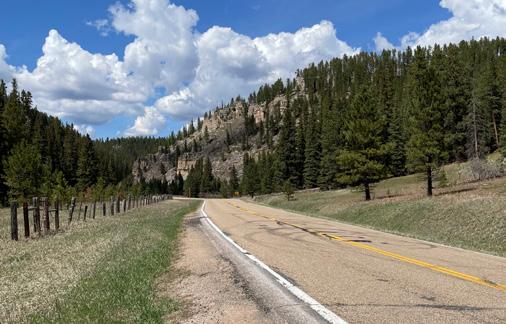
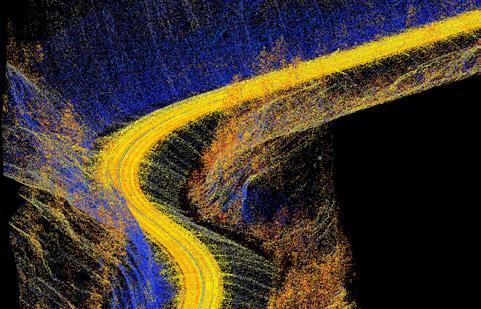
US Highway 85
Preliminary and Drainage Survey
Lawrence
County, SD
HEI’s survey team completed a unique and high-flying survey of US Highway 85 using a safety-first method of aerial data collection. This section of roadway, stretching from the Wyoming state line to Cheyenne Crossing, spans rugged terrain with steep grades, vertical cliffs, and densely-wooded areas. Due to these conditions, traditional survey methods would not be feasible. To achieve the most accurate survey possible, HEI used helicopter-based LiDAR to capture high-resolution topographic data across the corridor.
This approach kept surveyors out of traffic and hazardous terrain while still collecting the necessary drainage and roadway information. Timing was key to the successful completion of this survey. The team waited for snow to melt at high elevations, which helped to avoid gaps in the data caused by snow coverage. This timing helped produce a cleaner and more complete dataset allowing HEI to build a model of the existing ground surface. The completed model now acts as a foundation for future engineering and design work along this scenic stretch of highway. US Highway
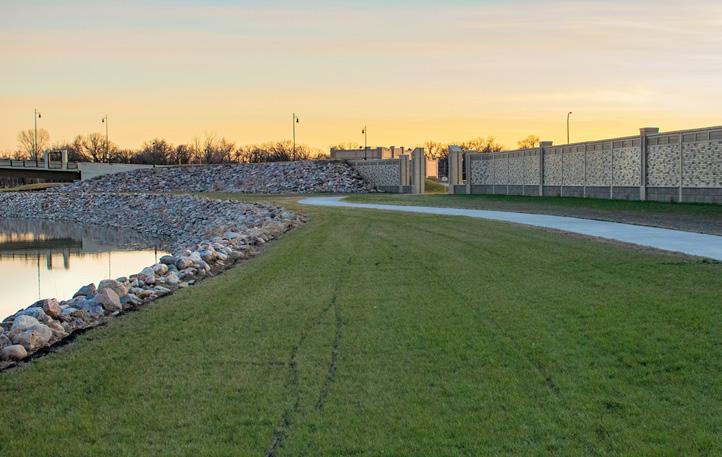
Phase MI-1 included 2,600 cy of concrete, 28,300 cy of levee fill material, and 19,300 cy of riprap placement.
Mouse (Souris) River Enhanced Flood Protection Project
Minot, ND
In 2011, a historic flood caused widespread damage to the City of Minot, ND. In response, the Souris River Joint Board launched the Mouse River Enhanced Flood Protection Project to protect the City and its more than 40,000 residents. Phase MI-1, completed in 2021, focused on the area near 4th Avenue Northeast. Work included utility replacements, roadway reconstruction, a sanitary sewer lift station, riverbank protection, concrete floodwalls, tieback levees, closure structures, and the Broadway Pump Station, which can expel up to 180,000 gallons of water per minute.
Phase MI-5 is nearing completion with crews constructing more than a mile of flood protection using floodwalls, earthen levees, and removable closures. This phase also includes a 30,000-gallon-per-minute stormwater pump station and realignment of 4,400 feet of roadway. MI-5A began in 2022 and is substantially complete, with final completion expected this fall. Phase MI-6 began in 2024 and will extend protection from downtown Minot through Roosevelt Park and into the Eastwood Park neighborhood, with expected completion in the summer of 2028. MI-6 also includes utility relocations, seepage barriers, floodwalls, levees, and a new pump station. Phase MI-8/9, known as the Burdick South Tieback Levee Project, is anticipated to begin in 2028. This phase will realign the East Burdick Expressway to pass over the Mouse River and relocate storm sewers, water mains, and sanitary sewers to accommodate new flood protection features. From MI-1 to MI-8/9, our team is dedicated to supporting the City in its vision for a more flood-resilient community.
EMPLOYEE SPOTLIGHTS
Getting to know Janel Kaufman
Janel is a Senior Civil Engineer and Principal in HEI’s Omaha, NE, office where she leads permitting, NEPA compliance, and watershed planning efforts for projects in Nebraska and Iowa. When choosing a career path, Janel knew she wanted to do something that could make a difference. After trying several other engineering fields in college (chemical, industrial, and biomedical), she settled on civil engineering because of her love for water resources. She graduated with a BS in civil engineering from the University of Nebraska and received her MS in civil and environmental engineering from the University of California - Berkeley. Her diverse background provides her with a unique perspective for not only traditional engineering projects but everything from watershed plans to water rights determinations.
Janel serves on the Board of Directors of Fontenelle Forest, one of Nebraska’s oldest conservation organizations, whose mission is to provide a place where people can experience and enjoy the quiet wild of nature. Located in Bellevue, NE, Fontenelle Forest is a beautiful place to hike in forests, wetlands, and prairie along the Missouri River. Janel enjoys going there to watch the seasons change, spotting those first Dutchman’s breeches (a flower, not actual pants!) as a sign of spring, visiting the raptors, and being part of an organization that means so much to the community.
Outside of work, Janel enjoys spending time with her family and friends, being outdoors, going on adventures, visiting family in Colorado, hanging out with her dogs, reading, doing puzzles, having kitchen dance parties, and eating delicious food. She admits to having a minor obsession with her AI bird feeder that she won at a silent auction at the Nebraska Association of Resources District conference and maybe shares one too many pictures of the birds, squirrels, raccoons, opossums, and spiders that visit!
Q&A
What has been your most memorable vacation and why?
I’ve had the pleasure of traveling across the US, Canada, and Europe, but my all-time favorite was Alaska last summer. The beauty there was breathtaking. What fuels your passion for your career?
I love solving puzzles and helping guide solutions that solve our clients’ needs, while minimizing impacts to the environment and staying within regulations. Environmental regulations are ever-changing, and staying current on these changes is part of the puzzle. When we begin a new project, our team sits down together to brainstorm and talk about the underlying problems, what we could do to solve them, and how we can tweak those solutions to fit within funding opportunities and permitting regulations. I get to utilize my engineering background and pair it with my love of the environment – no day is ever the same.
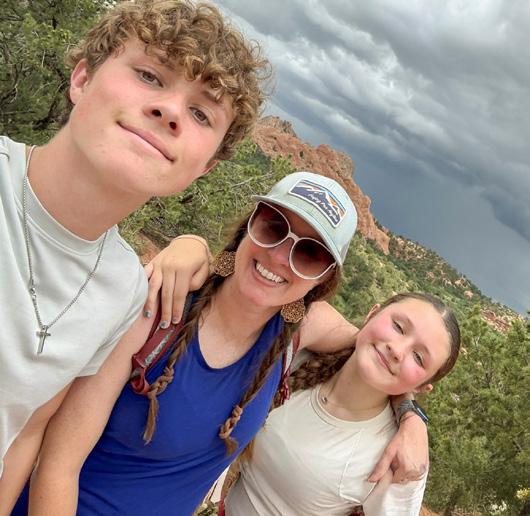



What do you like most about being part of the HEI team?
The best part of HEI is our people. Not only do I get to work with people who are brilliant and driven, they are compassionate, caring, and tons of fun.
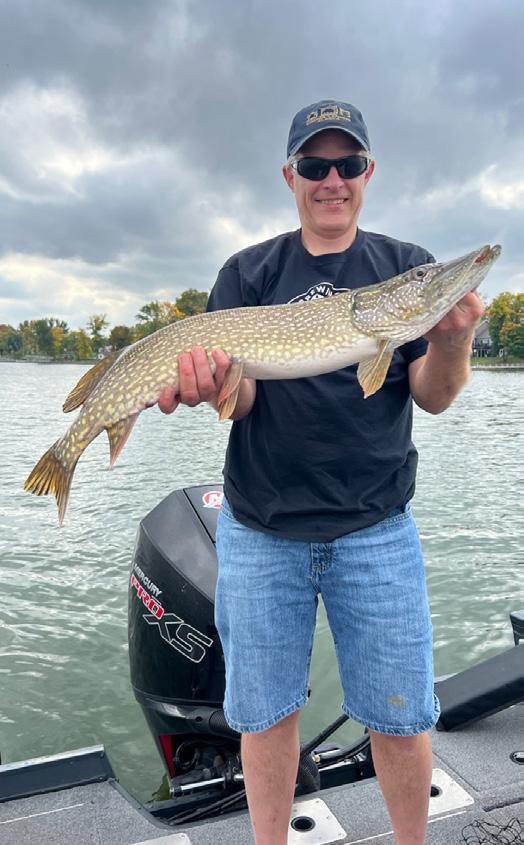
What professional advice would you like to pass along to others?
Never burn bridges. I can’t recall how many times I wrote off an encounter I had with a person, only to find that I bump into them or an acquaintance of theirs later in life.

Getting to know Chris Otterness
Chris is a senior civil engineer and the Water Resources Lead for HEI’s Maple Grove, MN, office, and currently serves as the District Engineer for the RCWD (see our cover article to learn more about our relationship with the District). Chris works as a client manager for several counties and watershed districts across Minnesota and spends his time serving those districts on the large variety of tasks they perform. He is experienced in the development and implementation of regional multipurpose water management projects that incorporate water quality, volume management, drainage, and wetland restoration. Chris also assists drainage authorities in maintaining and improving their public drainage systems. Chris says he wishes his superpower could be “Jack of all Trades,” which he certainly is for HEI.
Originally from Amery, WI, which is roughly an hour northeast of the Twin Cities Metro, Chris received his BS in civil engineering from the University of Minnesota in 1998. From inspecting water towers to becoming a project manager on land development projects, Chris’ winding career path led him to HEI.
Outside of work, Chris enjoys woodworking and fishing, two hobbies he combined by constructing his own fishing boat that he still uses to this day. He enjoys the cold Minnesota winters skiing with his two children, Gretchen (14) and Brad (10), and his wife, Nissa.


Q&A
What has been the most rewarding project you’ve worked on so far at HEI? Why? Most noteworthy to date probably was the Brown's Preserve/Judicial Ditch [JD] 4 Repair for the RCWD. This project was intended to address unpredictable and ineffective drainage from the cities of Forest Lake and Columbus where JD 4 traversed through a highly degraded wetland complex. We collaborated with the District to conceptualize a project that would provide solutions to multiple problems. This project included realignment of the ditch around the outside of the wetland, constructing an outlet structure to store water within the wetland, and rehabilitating the vegetation and soil structure to support native vegetation. The results included a reliable and more efficient outlet for agricultural and urban land uses upstream, decreases in upstream and downstream flooding, improved water quality, and the restoration of 120 acres of wetland habitat. The project also generated wetland banking credits that have facilitated subsequent regulatory approvals for the RCWD in other restoration projects that address drainage, flooding, and water quality.
Describe what you like about your job and being part of the HEI team. I thoroughly enjoy the people I work with and the clients I serve. I feel that is the key to having a successful and enjoyable career. The people I work with do not have big egos, are practical, and are highly motivated to serve the community.
Welcome to our team!





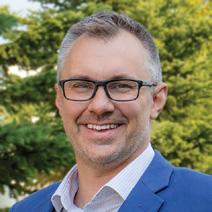













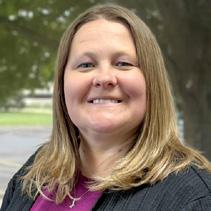








Remembering Hank Trangsrud
One of HEI’s founding partners, Hank Trangsrud, passed away in September. Hank joined the company as an officer in 1971 and played a crucial role in establishing our company's commitment to quality and honesty, retiring in 1996. Through his work in municipal engineering, Hank worked with farmers and rural communities to organize and design rural water systems in seven counties in North Dakota and two in South Dakota. This work paved the way for many of our present-day water supply and distribution projects.
A celebration of life was held for Hank on September 15 in Sun City West, AZ. He will be deeply missed by many, but his legacy will continue to inspire our company and culture, and the Fargo office 'Hank' conference room will keep him in our daily life.
Watch an interview with Hank from 2018.
Accomplishments, Events, and More!
Honored ... again!
For the 8th consecutive year, HEI has earned a spot on the ENR Top 500 Design Firms list!

HEI has once again been named one of the 50 Best Places to Work by Prairie Business magazine!

Sara Mechtenberg was named the new Office Manager for HEI’s Omaha, Nebraska office!

Thoughts Across Iowa!
We got to hear what engineer Kyle Werning thinks about while biking across the state of Iowa.
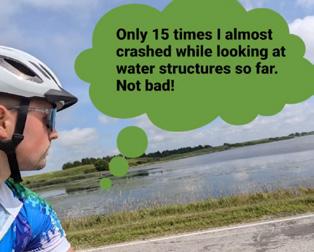
Giving Back Team members volunteered their time for a variety of worthy causes, including meal preparation and community events.



Donna Bye was honored during halftime at the NDSU Trees Bowl game for her work with the 1,000 Trees for Minot program (Now called the 2,000 Trees program!).

Wes Keller and Dan Hendrickx were interviewed by Prairie Business Magazine for two issues this summer about Parks and Recreation and the Pelican Rapids dam.

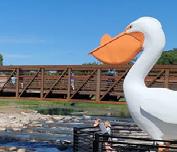
Read Wes' Article
Culture FUN HEI staff and families have had a blast during outdoor activities this summer and fall!


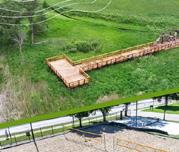
Read Dan's Article




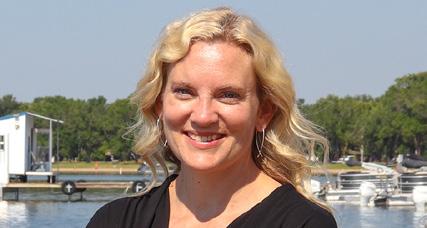
Moriya Rufer was invited to join the Minnesota Lake Management Society (MLMS) as a board member! MLMS is a local Minnesota chapter of the North American Lake Management Society.

New PEs
Congrats to Justin Kassen and Carter Ueland for earning their Professional Engineer licenses!
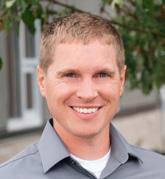

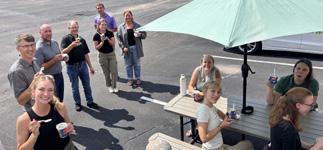

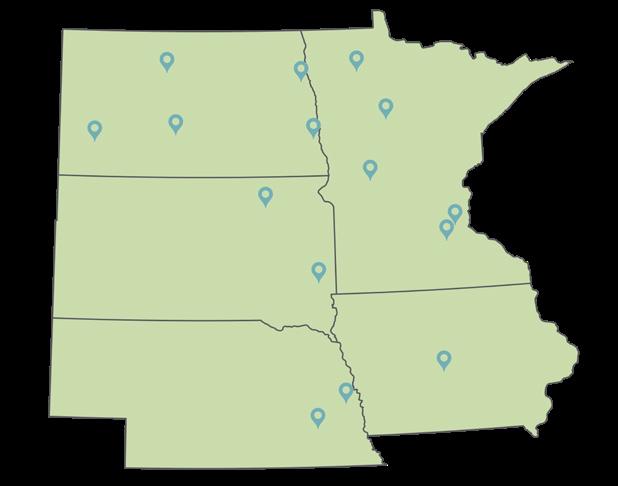
houstoneng.com
North Dakota Fargo | Bismarck | Dickinson Grand Forks | Minot
| Bemidji |
Grove | Thief River Falls
Prairie South Dakota Sioux Falls Aberdeen
Iowa Des Moines HEI is now in Alexandria AND Bemidji, MN
Growing to better serve communities! Conference season is in session
We are excited to expand our footprint with new office locations in Alexandria and Bemidji. These additions help us stay connected to the communities we serve and continue delivering innovative solutions across the region. Stop by and say hello!
As we head into the final stretch of 2025, we’re excited to participate in several key industry conferences that bring together professionals, innovators, and community leaders across the region.






few highlights:
MN Association of Soil and Water Conservation Districts (MASWCD) Annual Conference | Dec. 1-3
MN Watersheds Annual Conference | Dec. 3-5
Association of MN Counties (AMC) Annual Conference | Dec. 8-9
Joint ND Water Convention and Irrigation Workshop and Upper Missouri Water Association Conference | Dec. 9-11
